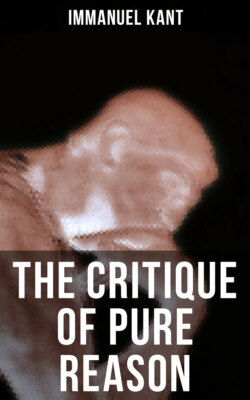Читать книгу THE CRITIQUE OF PURE REASON - Immanuel Kant - Страница 36
На сайте Литреса книга снята с продажи.
Section II. Transcendental Deduction of the pure Conceptions of the Understanding. §§ 11
ОглавлениеTable of Contents
Of the Possibility of a Conjunction of the manifold representations given by Sense.
The manifold content in our representations can be given in an intuition which is merely sensuous — in other words, is nothing but susceptibility; and the form of this intuition can exist a priori in our faculty of representation, without being anything else but the mode in which the subject is affected. But the conjunction (conjunctio) of a manifold in intuition never can be given us by the senses; it cannot therefore be contained in the pure form of sensuous intuition, for it is a spontaneous act of the faculty of representation. And as we must, to distinguish it from sensibility, entitle this faculty understanding; so all conjunction whether conscious or unconscious, be it of the manifold in intuition, sensuous or non-sensuous, or of several conceptions — is an act of the understanding. To this act we shall give the general appellation of synthesis, thereby to indicate, at the same time, that we cannot represent anything as conjoined in the object without having previously conjoined it ourselves. Of all mental notions, that of conjunction is the only one which cannot be given through objects, but can be originated only by the subject itself, because it is an act of its purely spontaneous activity. The reader will easily enough perceive that the possibility of conjunction must be grounded in the very nature of this act, and that it must be equally valid for all conjunction, and that analysis, which appears to be its contrary, must, nevertheless, always presuppose it; for where the understanding has not previously conjoined, it cannot dissect or analyse, because only as conjoined by it, must that which is to be analysed have been given to our faculty of representation.
But the conception of conjunction includes, besides the conception of the manifold and of the synthesis of it, that of the unity of it also. Conjunction is the representation of the synthetical unity of the manifold.17 This idea of unity, therefore, cannot arise out of that of conjunction; much rather does that idea, by combining itself with the representation of the manifold, render the conception of conjunction possible. This unity, which a priori precedes all conceptions of conjunction, is not the category of unity (§§ 6); for all the categories are based upon logical functions of judgement, and in these functions we already have conjunction, and consequently unity of given conceptions. It is therefore evident that the category of unity presupposes conjunction. We must therefore look still higher for this unity (as qualitative, §§ 8), in that, namely, which contains the ground of the unity of diverse conceptions in judgements, the ground, consequently, of the possibility of the existence of the understanding, even in regard to its logical use.
